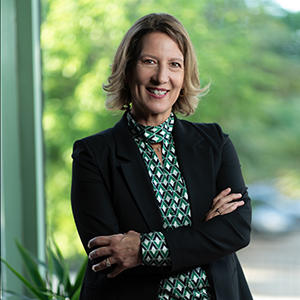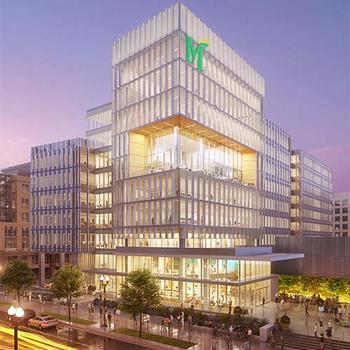
Read Dean Perry’s recent commentary in the Richmond Times Dispatch where she relays her journey from skeptic to advocate for VR’s potential to make it easier to scale health education and graduate more career-ready practitioners -- especially in light of a shrinking health workforce and multiple public health crises.
In This Story
The College of Public Health + Fuse at Mason Square accelerate potential for Virtual Reality-enhanced learning opportunities
The College of Public Health at George Mason University is an early mover in integrating virtual reality (VR) and augmented reality (AR) into student learning and workforce development. As the College expands its VR capabilities to reach every student, Fuse at Mason Square (Mason’s ambitious 345,000+ square foot innovation space in Arlington’s Rosslyn-Ballston corridor) is a natural home for cutting-edge VR and AR designed for innovative curriculum, partnerships, and community engagement.
In Fall 2023, Dean Melissa Perry launched a bold initiative to offer VR-enhanced experiences to every student in the College – and a $10 million fundraising campaign and partnership development initiative to make it possible. For Dean Perry and the team of innovators in the Virtual Reality and Simulation Lab, having an ambitious vision is the first step in making that plan a reality.
Despite the unlimited potential of VR and immersive technologies in the learning environment, there are three very real constraints in scaling quickly: developing custom content and curriculum; certifying more faculty in VR facilitation; and securing additional space to accommodate more learners.
“Building creative industry partnerships in these areas can be a win-win for everyone involved,” says Bethany Cieslowski, chief innovation officer for immersive technologies at the College. “Content, space, and certified faculty are three critical components to successfully scaling VR capabilities – and areas where collaboration with our communities will be key.”
Custom content and curriculum
VR is only as effective as the scenarios the students experience during a simulation – and creating a single scenario is a laborious process that can take days, weeks, or months depending the specificity of the objectives to ensure every interaction meets the associated learning objectives. Industry expertise and engagement from the community are necessary for this type of innovation and present a rich opportunity for collaboration.
“Innovation and idea-sharing across the public-private sector will be invaluable in developing a state-of-the-art curriculum that delivers career-ready graduates that meet employers’ evolving needs,” says Dean Perry. “Partnerships can help us address critical professional development, recertification, or accreditation needs of our neighboring health systems or government agencies.”
It may be surprising to learn that content development represents a significant portion of the total cost to deliver quality VR-enriched teaching. Working with industry leading VR-developer SimX, the College has created a library of scenarios and custom case content required for a school or college of public health. “To realize the full potential of VR and meet the urgent needs of this moment, we need to accelerate the innovation process by dedicating more resources to content development and execution,” says Dean Perry.
Certified faculty and simulation educators
Excellent content is the tip of the iceberg in delivering effective VR-enhanced learning. To fully leverage the potential of VR, highly skilled facilitators and simulation educators are vital – and often operate behind the scenes to create realistic learning experiences. Certified simulation facilitators deconstruct and reconstruct critical details of each scenario with evidence-based practices, building the foundation for successful learning and driving home the lessons from each immersive VR experience.
The College is building deep faculty expertise in facilitating VR simulations that address required competencies and learning objectives. Currently, the College has four Healthcare Simulation Educators with Certified Healthcare Simulation Educator (CHSE) credentials on staff. The Sim Educators design and deliver high quality simulations; assess, and evaluate the learners; deliver the educational objectives with respect to the highest industry standards; and continually seek to improve the simulation experience.
Cieslowski, who is also a Certified Healthcare Simulation Educator, envisions working in partnership with the private sector to meet the growing need for certified faculty. “Expanding and augmenting clinical learning opportunities with immersive technologies can alleviate some of the practical limitations associated with clinical placements,” says Cieslowski. “Further expanding our team of certified trainers will allow Mason to fulfill its mission of offering high quality VR simulation to every student who wishes to experience this innovation.”

Space to explore and expand
Ironically, teaching with Virtual Reality requires space. If you’ve ever completed a VR scenario, you know how vital it is to move freely and safely while remaining immersed in the learning experience. On average, a student needs 24 to 36 square feet to fully experience a simulation. Some scenarios, such as training for a mass casualty situation where multiple students are “in the same scenario,” can require even more room to maneuver. After every simulation, faculty and students debrief in a room dedicated to walking through student performance in detail and identifying opportunities to improve the next time around.
Established in 2021 as Virginia’s first interprofessional VR/Sim Lab, the College began by delivering innovative VR and high-quality simulation to nursing students and quickly expanded to additional degree programs in the College of Public Health.
The VR/Sim lab’s current infrastructure encompasses more than 1,500 square feet of dedicated VR/Simulation lab space. It includes the SimX VR platform, Oculus Quest 2 portable VR headsets, projectors, and gaming laptops. The library of VR cases provides nursing exposure to specialty areas, medical-surgical training, and interprofessional custom cases addressing opioid abuse and LGBTQ2+ health care.
To meet the growing demand for simulations in Fairfax and across Mason’s physical campuses, the Dean will extend the VR Sim Lab capabilities by using space in Research Hall on the Fairfax Campus and Fuse at Mason Square.
Expanding our impact virtually and around the region
Dean Perry sees unlimited potential in what the College can achieve with committed partners. “We look forward to having presence throughout the region, particularly at the Fuse innovation space, to reinforce our strong community relationships and reduce barriers to broader and rapid VR adoption.”
To discuss partnership opportunities regarding virtual reality, please contact Bethany Cieslowski at bcieslow@gmu.edu.
